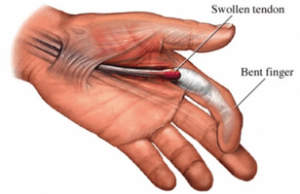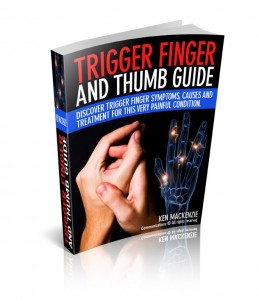Trigger finger symptoms may progress from mild to severe and include:
- Finger stiffness, particularly in the morning
- A popping or clicking sensation as you move your finger
- Tenderness or a bump (nodule) at the base of the affected finger
- Catching or locking your finger in a bent position, which suddenly pops straight
- Your finger is locked in a bent position, which you are unable to straighten
 Your trigger finger symptoms more commonly occurs in your dominant hand, and most often affects your thumb or your middle or ring finger.
Your trigger finger symptoms more commonly occurs in your dominant hand, and most often affects your thumb or your middle or ring finger.
Additionally, more than one finger may be affected at a time, and both hands might be involved.
Triggering is usually more pronounced in the morning, while firmly grasping an object or when straightening your finger.
Trigger finger symptoms develop when either the ring, middle, or index finger attempts to flex closed while gripping. Instead of a smooth, continual closure, the digit stutters, then snaps closed.
The closure is frequently associated with pain at the base of the digit on the palm of the hand. Trigger finger can affect the thumb.
Your trigger finger symptoms includes stiffness or catching in a finger joint – Then see a doctor:
If you have any stiffness or catching in a finger joint, bring it to the attention of your doctor so that he or she may review your trigger finger symptoms and perform a physical evaluation of your hand.
If your finger joint is hot and inflamed, seek immediate medical care because these signs indicate a possible infection.
How is trigger finger diagnosed?
No X-rays or lab tests are used to diagnose trigger finger. It is generally diagnosed following a physical exam of the hand and fingers. In some cases, the affected finger may be swollen and there may be a nodule, or bump, over the joint in the palm of the hand. The finger also may be locked in a flexed (bent) position, or it may be stiff and painful.
Trigger finger treatment
Risk factors
Factors that put you at risk of developing trigger finger include:
- Repeated gripping. Occupations and hobbies that involve repetitive hand use and prolonged gripping may increase your risk of trigger finger.
- Certain health problems. People who have diabetes or rheumatoid arthritis are at higher risk of developing trigger finger.
- Your sex. Trigger finger is more common in women.
- Carpal tunnel syndrome surgery. Trigger finger may be a complication associated with surgery for carpal tunnel syndrome surgery, especially during the first six months after surgery.
Trigger finger can affect any finger, including the thumb. More than one finger may be affected at a time, and both hands might be involved. Triggering is usually more pronounced in the morning, while firmly grasping an object or when straightening your finger.
Further information on Trigger Finger Causes
Best Selling Trigger Finger Splints on Amazon
= =>Don’t allow your trigger finger or thumb to go untreated – Click HERE <==
As an Amazon Affiliate I earn from qualifying purchases. TriggerFingerSymptoms.com is a participant in the Amazon Services LLC Associates Program, an affiliate advertising program designed to provide a means for sites to earn advertising fees by advertising and linking to Amazon.com,
Links on this trigger finger symptoms page are sponsored affiliate links and the owner makes commission if you buy after clicking these links. The owner is not a bona-fide user of this product. However, he has thoroughly researched it and provided a personal opinion only. This disclosure is in accordance with the Federal Trade Commission’s 16 CFR, Part 255: “Guides Concerning the Use of Endorsements and Testimonials in Advertising.”





